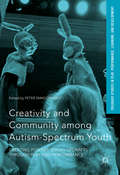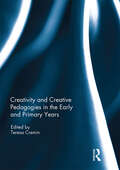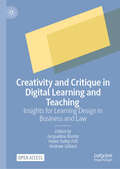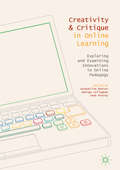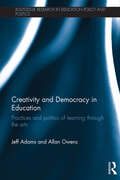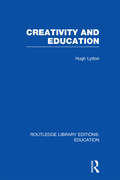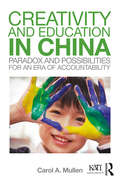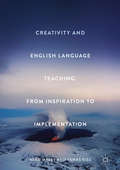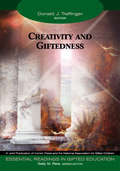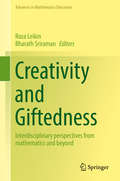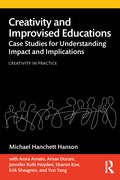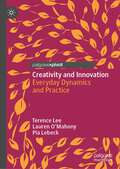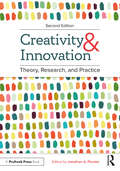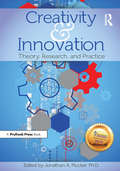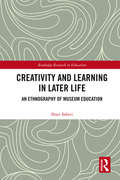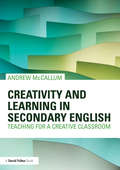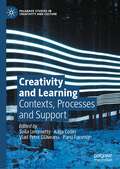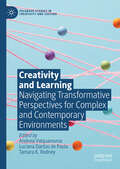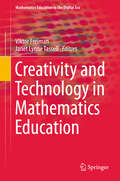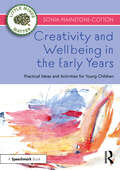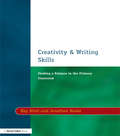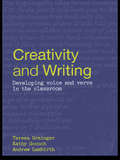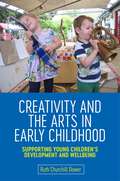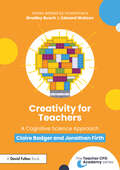- Table View
- List View
Creativity and Community among Autism-Spectrum Youth: Creating Positive Social Updrafts through Play and Performance (Palgrave Studies In Play, Performance, Learning, and Development)
by Peter SmagorinskyThis edited volume explores the roles of socially-channeled play and performance in the developmental trajectories of young people who fall on the autism spectrum. The contributors offer possibilities for channels of activity through which youth on the autism spectrum may find acceptance, affirmation, and kinship with others. "Positive social updraft" characterizes the social channels through which people of difference might be swept up into broader cultural currents such that they feel valued, appreciated, and empowered. A social updraft provides cultural meditational means that include people in a current headed "upward," allowing people of atypical makeups to become fully involved in significant cultural activity that brings them a feeling of social belonging.
Creativity and Creative Pedagogies in the Early and Primary Years
by Teresa CreminWhilst recognition of the role and nature of creativity and interest in creative pedagogical practice has grown, tensions persist at several levels, particularly in accountability cultures, where international comparisons of literacy, numeracy and science frame, shape and often limit policy, practice and curricula. Responding to this context, the book draws together the work of a number of eminent scholars of creativity and creative pedagogies. It offers diverse perspectives from Colombia, Denmark, England, France, Poland, Hong Kong, and the USA and highlights differences as well as similarities across cultural contexts. Individually and collectively, the authors reveal both the complexities and the possibilities of creative pedagogies. While some focus more upon conceptual challenges, others examine classroom practice, both that of teachers and visiting artists, and identify difficulties as well as potential possibilities. In offering hope as well as challenge, creative approaches to learning are of interest to all educators. This book was originally published as a special issue of Education 3-13: International Journal of Primary, Elementary and Early Years Education.
Creativity and Critical Thinking
by Steve PadgetWhat do we mean by creativity? What is the link between creativity and critical thinking? How can creativity and critical thinking be incorporated into classroom practice and what are the benefits for students? Creativity and critical thinking are central to effective teaching and learning and have a significant impact on students’ attainment, engagement, attendance and behaviour. This book draws on recent research and policy to provide teachers with a clear framework for understanding creativity and critical thinking and practically demonstrates how they can be incorporated into classroom practice. Bringing together an expert team of contributors with a wide-range of experience of bringing creative approaches into the classroom the book includes: an analysis of the issues associated with creativity and critical thinking clear guidance on how schools can develop dynamic thinking and creative learning strategies and use them with all learners advice on using external agencies to bring the creative perspective into schools case studies alongside examples of current activities and practice in schools links to resources and organisations who can offer support. Providing clear guidance on the underpinning theory and policy and drawing upon current initiatives in schools, this book is essential reading for trainee and practising teachers that want to provide the best possible learning experience for their students.
Creativity and Critique in Digital Learning and Teaching: Insights for Learning Design in Business and Law
by Jacqueline Baxter Andrew Gilbert Helen Selby-FellThis open access edited collection is aimed at educators, student services staff, and university management. It is timely in adopting a forward-facing view of various aspects of digital teaching and learning in business and law and provides a vital resource for those designing, managing or thinking about digital learning in both fields.
Creativity and Critique in Online Learning: Exploring and Examining Innovations in Online Pedagogy
by Jacqueline Baxter George Callaghan Jean McAvoyThis book explores emerging practices in distance education that have been facilitated by the development of educational technology. The volume examines core themes in distance education including online education at scale, embodiment in online environments, connectivity in online education and the personalisation of learning experiences within online education. The first section of the book examines online teaching tools, and explores how they are being used to enhance and promote student learning. The second looks at some of the broader challenges encountered by online teachers and those responsible for designing online learning material. While this volume will be of significant interest to distance learning universities and colleges, it will also be a valuable resource to traditional Higher Education Institutions, who are increasingly searching for innovative ways to reach and teach their students. This edited collection will be of value to scholars of online education as well as practitioners and policy makers looking to enrich their notions of online pedagogy.
Creativity and Democracy in Education: Practices and politics of learning through the arts (Routledge Research in Education Policy and Politics)
by Jeff Adams Allan OwensThe struggle to establish more democratic education pedagogies has a long history in the politics of mainstream education. This book argues for the significance of the creative arts in the establishment of social justice in education, using examples drawn from a selection of contemporary case studies including Japanese applied drama, Palestinian teacher education and Room 13 children’s contemporary art. Jeff Adams and Allan Owens use their research in practice to explore creativity conceptually, historically and metaphorically within a variety of UK and international contexts, which are analysed using political and social theories of democratic and relational education. Each chapter discusses the relationship between models of democratic creativity and the cultural conditions in which they are practised, with a focus on new critical pedagogies that have developed in response to neoliberalism and marketization in education. The book is structured throughout by the theories, practices and the ideals that were once considered to be foundational for education: democratic citizenship and a just society.Creativity and Democracy in Education will be of key interest to postgraduate students, researchers, and academics in the field of education, especially those interested in the arts and creativity, democratic learning, teacher education, cultural and organisational studies, and political theories of education.
Creativity and Education (Routledge Library Editions: Education)
by Hugh LyttonThe author gives a lucid account of creativity and its educational context. He discusses the creative process, the character of different kinds of creativity, creative people, developing creativity, and the creative child at school, to give his readers an understanding of the issues that home or school have to face in fostering a creative, non-habit-bound child. The book should be particularly welcome to all concerned with education in view of the present stress on child-centred education and on the development of individual children’s abilities, especially their powers of original thought and search to the full.
Creativity and Education in China: Paradox and Possibilities for an Era of Accountability (Kappa Delta Pi Co-Publications)
by Carol A. MullenPublished with Kappa Delta Pi, Creativity and Education in China takes readers on a journey through research-supported ideas and practical examples of creative and innovative schooling within a changing regime. Analyzing the consequences of exam-centric accountability on the creative and critical capacities of Chinese students, author Carol A. Mullen’s dynamic portrait of a country serves as both a cautionary tale and an inspiring example to emulate. Examining creative endeavors and breakthroughs within a competitive, globalized educational landscape, the chapters are organized around environmental and global issues impacting education, expressions of creativity within pre-K–12 schools in China, and creative innovation in higher education learning environments. Presenting captivating cases from the field, the book offers novel approaches to fostering creativity as a natural, integrated part of high-stakes education systems in Eastern and Western cultures alike.
Creativity and English Language Teaching: From Inspiration to Implementation
by Alan Maley Tamas KissThis book offers a unique perspective on creativity in an educational environment where there is a relative dearth of literature on this subject. The authors link practice and principle to provide a practical and valuable guide for more creative language learning and teaching, using not only theoretical ideas but useful practical advice and recommendations on how better to introduce creativity into teaching and daily life. This innovative volume is sure to become a crucial reference point for teachers and practitioners of language teaching, and anyone interested in the ways in which creativity can be channelled into the teaching and learning process.
Creativity and Giftedness
by Sally M. Reis Dr Donald J. TreffingerMisconceptions about the connection between creativity and giftedness are discussed, as well as how to nurture creativity in students.
Creativity and Giftedness: Interdisciplinary perspectives from mathematics and beyond (Advances in Mathematics Education #6)
by Roza Leikin Bharath SriramanThis volume provides readers with a broad view on the variety of issues related to the educational research and practices in the field of Creativity in Mathematics and Mathematical Giftedness. The book explores (a) the relationship between creativity and giftedness; (b) empirical work with high ability (or gifted) students in the classroom and its implications for teaching mathematics; (c) interdisciplinary work which views creativity as a complex phenomena that cannot be understood from within the borders of disciplines, i. e. , to present research and theorists from disciplines such as neuroscience and complexity theory; and (d) findings from psychology that pertain the creatively gifted students. As a whole, this volume brings together perspectives from mathematics educators, psychologists, neuroscientists, and teachers to present a collection of empirical, theoretical and philosophical works that address the complexity of mathematical creativity and giftedness, its origins, nature, nurture and ways forward. In keeping with the spirit of the series, the anthology substantially builds on previous ZDM volumes on interdisciplinarity (2009), creativity and giftedness (2013).
Creativity and Improvised Educations: Case Studies for Understanding Impact and Implications (Creativity in Practice)
by Michael Hanchett HansonExamining the improvised relationships among lifelong learning, formal education, and creativity, this volume provides detailed case studies of the creative work of people from a wide variety of fields. Each profile allows readers to explore how real people’s distinctive points of view, senses of purpose, and ultimate contributions developed through participation in complex worlds. By looking at creativity as a distributed and participatory process, these cases deconstruct the myth of solitary creative genius, while exploring applications of complexity theory to creative work and raising new questions for creativity research. Providing a framework for thinking about education, agency, and change, this book is valuable for both students and researchers seeking concrete ways to broaden their understanding of creativity in practice.
Creativity and Innovation: Everyday Dynamics and Practice
by Terence Lee Lauren O'Mahony Pia LebeckThis book provides a broad overview of the theory and practice of creativity and innovation. It is an interdisciplinary study that synthesizes the popular, complex and contemporary discourses on the topic. The approach of the book is centred on praxis, that is, it is grounded strongly in research-based theories, but aims to offer ideas on how to apply creativity and innovation in the everyday context. The authors present an expansive and well-informed perspective on creativity and innovation that transcends any single discipline or specialist area, making the book accessible, readable and memorable. Above all, the reader will be able read the book with a high degree of ease, grasp and retain key and critical concepts of creativity (and the creative process) and innovation (and the innovative process) as well as consider ways of applying them in their everyday lives across all vocations and professional contexts.
Creativity and Innovation: Theory, Research, and Practice
by Jonathan A. PluckerCreativity and innovation are frequently mentioned as key skills for career and life success in today’s world. This award-winning book brings together some of the world's best thinkers and researchers to offer insights on creativity, innovation, and entrepreneurship. The new edition features fully updated chapters, including expanded coverage of exciting topics such as group creativity, ethics, development, makerspaces, and lessons from other fields. Educational applications are emphasized throughout. Creativity is often the spice of life, that little extra something that makes the mundane into the interesting, making our routines into fresh new approaches to our daily lives. With this book’s comprehensive and readable approach, you’ll be able to understand what creativity truly is (and isn't), how to foster it, and how it relates to intelligence, leadership, personality, and other concepts.
Creativity and Innovation: Theory, Research, and Practice
by Jonathan A. PluckerCreativity and innovation are frequently mentioned as key 21st-century skills for career and life success. Indeed, recent research provides evidence that the jobs of the future will increasingly require the ability to bring creative solutions to complex problems. And creativity is often the spice of life, that little extra something that makes the mundane into the interesting, making our routines into fresh new approaches to our daily lives. Over the past quarter century, our understanding of creativity has advanced significantly—we know more about what it is (and isn't), we better understand how to foster it, and we have deeper, more complex knowledge about how it relates to intelligence, leadership, personality, and other constructs. This book brings together some of the world's best thinkers and researchers on creativity, innovation, and entrepreneurship to provide a comprehensive but highly readable overview of these exciting, important topics.
Creativity and Learning in Later Life: An Ethnography of Museum Education (Routledge Research in Education)
by Shari SabetiCreativity and Learning in Later Life examines how processes such as ‘creativity’ and ‘inspiration’ are experienced by writers who engage with the visual arts, and questions how age is perceived in relation to these processes. The author’s careful analysis challenges many of the assumptions on which museum education currently operates, contributing to wider debates surrounding the value of arts and cultural heritage education. Containing detailed descriptions of museum tours, viewers’ engagements with specific artworks, and the processes of creative writing and editing that result from such encounters, the book draws on a ground-breaking study to challenge the way in which the value of education and creative activity for older adult learners has been conceptualized in existing literature. It also demonstrates how learners adapt and subvert the intended pedagogies to suit their own needs and accommodate their ageing selves. Drawing on a spectrum of disciplines including education, anthropology, art history, sociology, museum studies and the practice and theory of creative writing, this book will be of interest to academics, postgraduate students, and researchers in a range of fields, as well museum practitioners, creative writing teachers and those working in adult and community education settings.
Creativity and Learning in Secondary English: Teaching for a creative classroom
by Andrew McCallumCreativity in secondary English lessons today is a democratically conceived quality that all pupils are expected to achieve and a resource on which all are entitled to draw. But what exactly is creativity? And how does it relate to English? Creativity and Learning in Secondary English answers these questions, and others, by arguing for a version of creativity that sees it as an ordinary, everyday part of successful classroom practice, central to processes of meaning-making, dialogic interaction and textual engagement. In this construction, creativity is not just linked to learning; it is the driving force behind learning itself, offering pupils the opportunity to transform their knowledge and understanding of the world around them. This book borrows from a range of theories about creativity and about learning, while remaining largely practical in focus. It contains numerous examples for teachers of how to apply ideas about creativity in the classroom. In doing so, it attempts to maintain the subject’s core identity while also keeping abreast of contemporary social, pedagogical and technological developments. The result is a refreshing challenge to some of the more mundane approaches to English teaching on offer in an age focussed excessively on standardisation and teaching to tests. Practical applications of creativity include: Using picture books and graphic novels to stimulate multimodal responses Placing pupils in the role of the teacher Devising marketing campaigns for class novels Adopting experimental approaches to redrafting Encouraging ‘extreme’ forms of re-creative writing Focusing on how to ‘listen’ to texts Creating sound-scapes for poems Thought-provoking and provocative, this textbook draws on current best practice in English teaching and will equip trainee and practising teachers with a wide range of strategies that will lead to greater creativity in the classroom.
Creativity and Learning: Contexts, Processes and Support (Palgrave Studies in Creativity and Culture)
by Vlad Petre Glăveanu Soila Lemmetty Kaija Collin Panu ForsmanThis book focuses on the relations and connections between creativity and learning in different contexts. By shifting the focus from individual psychology to a sociocultural framework, it explores the multidimensional nature of the processes under study, resulting in a ‘bigger picture’ of creativity and learning and their interdependence. The book examines the sociocultural definitions of creativity and learning in the contexts of children’s education and adult education, as well as workplaces and organisations. It offers insights concerning the frameworks and practices developed to enhance creativity and learning in different applied contexts. This collection brings together experts from across the globe and combines theoretical understandings, recent empirical findings and practical tools to be used by researchers, students and teaching staff, as well as practitioners, educators and managers. The book is a comprehensive, research-based volume on creativity and learning and their dynamic interconnection in various spheres of our life.
Creativity and Learning: Navigating Transformative Perspectives for Complex and Contemporary Environments (Palgrave Studies in Creativity and Culture)
by Andreia Valquaresma Luciana Dantas de Paula Tamara K. RodneyThis book brings together transformative perspectives on creative education. Creativity, creative education and pedagogy are not exempt from the impact of the complexities of our world. In fact, there seems to be an increasing demand for designing learning environments that are more able to support multiple modes of (inter)acting with the other and the world. It is a mandate of our time to increase learning opportunities in socioculturally diverse contexts. In this light, this book examines how creativity is shaped by sociocultural factors, and how it can be pivotal in challenging dominant narratives and entrenched pedagogies. Drawing on a diverse range of conceptual and practice-oriented chapters that include voices from the Global North and the Global South, this edited collection offers a pragmatic analysis of how the future of creativity in education could be shaped. Ultimately, it seeks to contribute to an understanding of creativity as a necessary tool for social transformation and the recognition that this transformation happens in multiple spheres. A thought-provoking analysis of how the future of creativity in education could be shaped to promote equitable learning environments, this is an ideal resource for creatives, academics, and students in the fields of education, psychology, and pedagogy, as well as practitioners and professionals interested in implementing creative diversity in education.
Creativity and Technology in Mathematics Education (Mathematics Education in the Digital Era #10)
by Viktor Freiman Janet Lynne TassellThis volume provides new insights on creativity while focusing on innovative methodological approaches in research and practice of integrating technological tools and environments in mathematics teaching and learning. This work is being built on the discussions at the mini-symposium on Creativity and Technology at the International Conference on Mathematical Creativity and Giftedness (ICMCG) in Denver, USA (2014), and other contributions to the topic. The book emphasizes a diversity of views, a variety of contexts, angles and cultures of thought, as well as mathematical and educational practices. The authors of each chapter explore the potential of technology to foster creative and divergent mathematical thinking, problem solving and problem posing, creative use of dynamic, multimodal and interactive software by teachers and learners, as well as other digital media and tools while widening and enriching transdisciplinary and interdisciplinary connections in mathematics classroom. Along with ground-breaking innovative approaches, the book aims to provide researchers and practitioners with new paths for diversification of opportunities for all students to become more creative and innovative mathematics learners. A framework for dynamic learning conditions of leveraging mathematical creativity with technology is an outcome of the book as well.
Creativity and Wellbeing in the Early Years: Practical Ideas and Activities for Young Children (Little Minds Matter)
by Sonia Mainstone-CottonThis accessible and practical guide explores how we can enhance and embed creativity in the early years to support children’s wellbeing. The book initially explores the work of Anna Craft, Ken Robinson, and Reggio Emilia to think about creativity with young children, before considering what this means for wellbeing. Five core chapters focus on creative mediums – drawing, sculpting and painting; craft; music; dance and drama; and storytelling and poetry – and offer a range of practical ideas and activities to use and adapt. This book provides: A wide range of activities accompanied by examples of collaborative arts projects with children. Interviews with artists and practitioners who support children’s wellbeing using creative mediums. Recommendations for creative activities using accessible and everyday materials. Case studies showing the positive impact of creativity, from developing children’s cultural understanding to soothing and supporting children with sensory experiences. Suggestions for enthusing children with a love of words, enabling them to express their thoughts and feelings through creative language. Moments for reflection to encourage readers to pause and consider the impact of creativity on their own wellbeing as well as the wellbeing of children in their care. With ideas included that every practitioner can use in their setting, this book is an essential tool for early years professionals who want to build their confidence in using creativity in their practice whilst supporting children’s wellbeing.
Creativity and Writing Skills: Finding a Balance in the Primary Classroom
by Kay Hiatt Jonathan RookeTeachers, trainees and learning support assistants will find this lively and accessible book combines creativity with skills teaching to stimulate and improve children's writing, both at foundation and primary levels. Based on the concepts and objectives of the National Literacy Strategy (NLS), the content is well founded in experience, research and classroom application. Special features include advice on planning, linking to NLS objectives, and selecting texts; demonstration scripts for teachers to use in the classroom; annotated extracts from quality literature to help children read as writers; practical advice on strategies to use in guided writing; and examples of children's work that show how to assess the children's writing and set 'next step' targets. The authors show how you can use drama techniques, story stacks, artifacts and scenarios to engage children in writing, both in fiction and non-fiction, right across the curriculum.
Creativity and Writing: Developing Voice and Verve in the Classroom
by Kathy Goouch Andrew Lambirth Teresa GraingerThis clear yet authoritative book affirms the vital role of creativity in writing and considers and encourages flexible, innovative practices in teaching. Importantly, the book reflects upon teachers' imaginative and artistic involvement in the writing process as role models, collaborators, artists, and as writers themselves. Arguing that children's creative use of language is key to the development of language and literacy skills, this book focuses on the composition process and how children can express their own ideas. In addition, the authors consider the many forms of creative language that influence the inner and outer voice of children, including reading, investigating, talking and engaging in a range of inspiring activities. Illustrated throughout with many examples of children's writing and drawing, this book also provides suggestions for classroom activities and is a source of inspiration and practical guidance for any teacher looking to deepen their understanding of literacy theory and practice.
Creativity and the Arts in Early Childhood: Supporting Young Children’s Development and Wellbeing
by Ruth Churchill Churchill DowerOffering practical guidance on encouraging creativity in early childhood settings, this much-needed book highlights the importance of the arts and creativity for children's learning, critical thinking, social interaction and self-regulation.The book considers the impact of creativity on early brain development and discusses how to choose the right arts or creative approach for your children. Principles for creative curriculums, teaching, assessments and environments are provided and each chapter includes a 'practitioner toolkit' element, with reflective questions and practical strategies for implementing the learning from the chapter into daily practice.
Creativity for Teachers: A Cognitive Science Approach (The Teacher CPD Academy)
by Claire Badger Jonathan FirthCreativity is a word that is widely used in education, but in ways that are not always consistent or in line with research. This exciting new book explores how creativity is not something additional, but which is infused throughout learning, relevant to every subject and student.Taking a cognitive science approach, it presents creativity in terms of building competencies. It challenges the view that schools kill creativity or that only some types of tasks count as creative. By setting up existing lessons in ways that involve more flexibility and uncertainty, we can both boost creativity and build a more flexible academic expertise along the way. Featuring practical classroom examples, research evidence, and case studies which will guide practitioners and provide a timely antidote to stale skills vs. knowledge arguments, the chapters include: Cognitive science and creativity Creativity across subject disciplines Linking creativity and knowledge Freedom vs. constraints Expertise and metacognition Assessing creativity Motivation and school culture Creative teachers and creative teaching Part of The InnerDrive Teacher CPD Academy series that offers a deep dive into the key areas that matter to teachers, this is essential reading for all teachers and school leaders wanting to develop their understanding of what creativity looks like in the classroom so they can better support their students.
